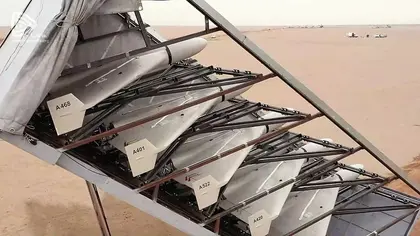Sergey Surovikin, former commander-in-chief of the Russian Aerospace Forces and now top commander of Russia’s assault on Ukraine, is fighting a battle to defeat Ukraine’s air defenses. He needs to do this for two reasons: i) without Russian air superiority, a Russian strategic offensive is unlikely; and ii) even worse for him, if Ukraine takes over control of its own skies, a Russian military defeat becomes more possible.
A favorite weapon in Surovikin’s campaign to dominate Ukraine’s skies is the Shahed-136 drone. It is not especially high-tech. It’s loud, vulnerable to jamming, flies in a straight line to a pre-programmed grid coordinate, and travels not much faster than an automobile. Ukrainian policemen have shot them down using automatic pistols.
Military experts say Surovikin is launching waves of Shaheds at Ukraine – estimated at between 150 and 200 since the start of October. Their aim seems not so much about blowing things up, but feeling out Ukrainian air defenses and forcing Ukrainians to launch expensive anti-aircraft missiles on dirt-cheap Iranian drones.
“If there were 2,000 to 3,000 of them [Shahed drones], then Ukraine would face a completely different situation on the battlefield,” military expert Agil Rustamzade said in an Oct. 12 interview on the “News from the Caucasus” (GSAC) channel.
”Yes – [these drones] are a serious weapon, and should not be underestimated, but because of their technical limitations and small numbers, they will not make be a game changer in the war,” he pointed out.

Russian Attacks on Ukraine Energy Could Trigger ’Tipping Point’: UN
Russia’s objectives in the use of drones
Rustamzade explained that attacks are being carried out in small groups to disperse Ukrainian air defense systems and to help Russian attackers detect the locations and types of those systems. During drone attacks, Ukrainian air defenses become visible, turn on radars and put their weapons to combat readiness. This helps Russian intelligence identify their locations, with the goal of further destruction.
“Kamikaze drones are a weapon of asymmetric warfare. They win even if they are shot down. The drone takes off and has already [effectively] completed its task because it causes the expenditure of an expensive missile which has no replacement. Ukraine will [soon] receive [the high tech] NASAMS anti-aircraft missile system and missile reloads for it. But where will Ukraine now find a missile for the [Soviet-era] S-300, S-125, and Osa air defense systems?” Rustamzade questioned.
A further goal of Surovikin’s drone attacks is to strike infrastructure and terrorize Ukraine’s civilian population, with the objectives of undermining public resistance and forcing the Ukrainian military command to shift air defense systems away from the front line to the rear.
“Strikes on energy infrastructure and facilities are the only trump card remaining [for the Russian military] to put pressure on the population of Ukraine,” said Yigal Levin, Israeli military expert, in an interview on the “Nastoyashaye Vremya” channel on Oct. 18.
The Kremlin’s goal is to “intimidate the Ukrainian people” so that “winter will be difficult” and to “force President Volodymyr Zelensky to sit down at the negotiating table with [Russian President Vladimir] Putin,” Levin said.
How Ukraine should respond
Military observers argue that Ukraine’s army should respond to drone attacks by being stealthy and agile. Camouflage, dummy weapons, efficient transport, and effective defensive positions are all important tactics to respond to incoming Russian missiles and drones, they say.
Rustamzade, in an Oct. 18 interview on the Ukrlife.tv channel, noted that Ukraine should decentralize infrastructure, in particular the energy system. He recommended deploying backup electricity production capacity, so that when one station is taken offline or interferes with the operation of another, power can be generated by alternate means.
According to Ukrainian journalist Yurii Butusov, the U.S. military possesses powerful air defense systems and could, for instance, deploy high tech Patriot interceptor missiles to Ukraine. But for real air superiority, and “for air combat and the use of modern air-to-air missiles, Ukraine needs F-16 (combat) aircraft,” he said.
Butusov also recommended that Ukraine consider fielding light propeller combat aircraft such as EMB-314 Super Tucano. This is because these planes can be optimized for intercepting Iranian kamikaze drones and are easily adapted for strikes on ground targets.
Rustamzade said that old-school anti-aircraft guns also have a place in modern Ukrainian air defense.
“A competent machine gunner standing on the last line of defense near the power plant, with a 12.7-mm heavy machine gun with explosive bullets…or ZU-23-2 anti-aircraft guns…would be a quick and effective way for Ukraine to strengthen its anti-drone defenses,” Rustamzade said. He emphasized that this would be quicker than training crews, which would take one to two weeks.
Experts generally agree that it is unlikely any Ukrainian air defense system will completely protect all civilian structures from Russian air attacks.
“Even the well-known Israel ‘Iron Domes’, which have been on duty since 2014, still [sometimes] miss the interception of home-made munitions,” said Peter Chernik in a Oct. 19 “Radio HB” interview.
”The bottom line is that we [Ukraine] are increasing the quality of our knowledge on [how we] shoot down these drones. And I am sure that in a few weeks, we will reach the figure of 95 percent of downed UAVs, and maybe a little higher,” Chernik said.
You can also highlight the text and press Ctrl + Enter






